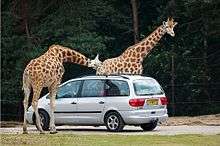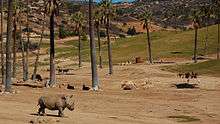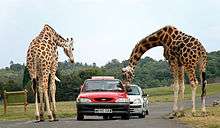Safari park
A safari park, sometimes known as a wildlife park, is a zoo-like commercial drive-in tourist attraction where visitors can drive their own vehicles or ride in vehicles provided by the facility to observe freely roaming animals.



The main attractions are frequently large animals from Sub-Saharan Africa which people can see in wildlife reserves such as giraffes, lions, rhinocerotes, elephants, hippopotamus, zebras, ostriches, buffalo, oryx, sometimes dromedary camels, pelicans, geese, ibis, geese, ankole cattle, cheetahs, hyenas, baboons, wild dogs and antelope (eland, lechwe, wildebeest, nyala, impala, waterbuck, sable antelope, kudu and roan antelope just to name a few). Most safari parks have a "walk-around" area with animals too small or too dangerous to be roaming freely in the reserves, like Tapir, Small Antelope, Squirrel Monkey, Penguins, Marmosets, Tamarins, Mongoose, Meerkats, Lemurs, Wallabies, Small Birds, Gorillas, Reptiles, Hornbills, Small Monkeys, Chimpanzee, capybara, llamas, emus, red pandas, snow leopards, otters and Warthogs. Some also have Children's Zoos, aquariums, butterfly houses and reptile and insect houses. Besides animals, in the walk-round area this is where public facilities like toilets, snack bars and cafes, play areas and sometimes amusement rides. There can be walk-through exhibits with animals like kangaroos, lemurs and wallabies. The Knowsley Safari in England keeps Amur Tigers and Giraffes in their walking area.
A safari park is larger than a zoo and smaller than a game reserve. For example, African Lion Safari in Hamilton, Ontario, Canada is 750 acres (3.0 km2). For comparison, Lake Nakuru in the Great Rift Valley, Kenya, is 168 square kilometres (65 sq mi), and a typical large game reserve is Tsavo East, also in Kenya, which encompasses 11,747 square kilometres (4,536 sq mi).
Safari parks often have other associated tourist attractions: golf courses, carnival rides, cafes/restaurants, ridable miniature railways, boat trips where people could see animals in the water like sea lions, life-sized recreations of dinosaurs and other prehistoric animals, plant mazes, playgrounds, monorails, cable cars and gift shops. These are commonly found in the walk around area.
Many parks have conservation programmes with endangered animals like elephants, rhinos, giraffes, lions, tigers, cheetahs and wild dogs.
History and List Of Parks

The predecessor of safari parks is Africa U.S.A. Park (1953–1961) in Florida.[1]
The first lion drive-through opened in 1963 in Tama Zoological Park in Tokyo. In double-glazed buses, visitors made a tour through a one-hectare enclosure with twelve African lions.
The first drive-through safari park outside of Africa opened in 1966 at Longleat in Wiltshire, England.[2][3] Longleat, Windsor, Woburn and arguably the whole concept of safari parks were the brainchild of Jimmy Chipperfield (1912–1990), former co-director of Chipperfield's Circus, although a similar concept is explored as a plot device in Angus Wilson's "The Old Men at the Zoo" which was published five years before Chipperfield set up Longleat.[4] Longleat's Marquess of Bath agreed to Chipperfield's proposition to fence off 40 hectares (100 acres) of his vast Wiltshire estate to house 50 lions. Knowsley, the Earl of Derby's estate outside Liverpool, and the Duke of Bedford's Woburn estate in Bedfordshire both established their own safari parks with Chiperfield's partnership. Another circus family, the Smart Brothers, joined the safari park business by opening a park at Windsor for visitors from London. The former Windsor Safari Park was in Berkshire, England, but closed in 1992 and has since been made into a Legoland. There is also Chipperfield's "Scotland Safari Park" established on Baronet Sir John Muir's estate at Blair Drummond near Stirling, and the American-run "West Midland Safari and Leisure Park" near Birmingham. One park along with Jimmy Chipperfield at Lambton Castle in the North East England has closed.
Between 1967 and 1974, Lion Country Safari, Inc. opened 6 animal parks, one near each of the following American cities: West Palm Beach, Florida; Los Angeles, California; Grand Prairie, Texas; Atlanta, Georgia; Cincinnati, Ohio; and Richmond, Virginia. The first park, in South Florida, is the only Lion Country Safari still in operation.
Burgers' Zoo at Arnhem, Netherlands, opened a "safari park" in 1968 within a traditional zoo. In 1995, Burgers' Safari modified this to a walking safari with a 250-metre (820 ft) board walk. Another safari park in the Netherlands is SafariparkBeekse Bergen.
Most safari parks were established in a short period of ten years, between 1966 and 1975.
- Europe
- Belgium : Aywaille (Le Monde Sauvage, (1975)
- Great Britain Longleat (1966), Windsor (1969–1992), Woburn (1970), Knowsley (1971), Lambton (Lion Park, 1972–1980), Bewdley (West Midland Safari Park, 1973), Blair Drummond (1970), Highland Wildlife Park (1972)
- France : Thoiry (Réserve Africaine, 1968), Peaugres (Safari de Peaugres, 1974), Sigean (Réserve africaine de Sigean, 1974), Saint-Vrain (Parc du Safari de Saint-Vrain, 1975–1998), Obterre (Haute Touche Zoological Park, 1980) owned by the Muséum national d'histoire naturelle, Port-Saint-Père (Planète Sauvage, 1992)
- Netherlands : Hilvarenbeek (Safaripark Beekse Bergen, 1968)
- Germany : Gelsenkirchen (Löwenpark, 1968–1989), Tüddern (Löwen-Safari,1968–1990), Stuckenbrock (Safariland Stuckenbrock, 1969), Hodenhagen (Serengeti Park, 1974)
- Italy : Bussolengo (Parco Natura Viva), 1969), Fasano (Zoosafari, 1973), Pombia (Safari Park, 1976), Murazzano (Parco Safari delle Langhe, 1976), Ravenna (Safari Ravenna, 2012)
- Denmark : Givskud (Løveparken, 1969), Knuthenborg (Knuthenborg Safari Park, 1969), Ebeltoft (Ree Park – Ebeltoft Safari, 1991)
- Sweden : Kolmården (Safari Park, 1972–2011), Smålandet (Markaryds Älg & Bison Safari,?)
- Austria : Gänserndorf (Safaripark, 1972–2004)
- Spain : Cabárceno (Parque de la Naturaleza, 1990)
- Portugal : Badoca Safari Park (Badoca Safari Park)
- Russia : Kudykina Gora (Кудыкина гора)
- Americas
- United States
- Arizona : Camp Verde (Out of Africa Wildlife Park, 1988)
- Arkansas : Gentry (Wild Wilderness Drive-Thru Safari, 1970)
- California : Escondido (San Diego Zoo Safari Park, formerly San Diego Wild Animal Park, 1972)
- Florida : Loxahatchee (Lion Country Safari, 1967)
- Louisiana : Epps (High Delta Safari Park)
- Maryland : Largo (The Largo Wildlife Preserve, 1973–1978, now the site of Six Flags America)
- Nebraska : Ashland (Lee G. Simmons Conservation Park and Wildlife Safari)
- New Jersey: Jackson (Great Adventure, 1974, now the site of Six Flags Great Adventure & Wild Safari)
- New Jersey: West Milford ("Warner Brothers Jungle Habitat", 1972-1976)
- Texas : Grand Prairie (Lion Country Safari, 1971–1992), San Antonio (Natural Bridge Wildlife Ranch, 1984), Glen Rose (Fossil Rim Wildlife Ranch, 1984)
- Oregon : Winston (Wildlife Safari, 1973)
- Ohio : Port Clinton (African Safari Wildlife Park, 1973), Mason (Lion Country Safari at Kings Island, 1974–1993)
- Virginia : Doswell (Lion Country Safari at Kings Dominion, 1974–1993), Natural Bridge(Virginia Safari Park, 2000)
- Georgia : Pine Mountain (Wild Animal Safari, 1991)
- Canada
- Ontario : Flamborough (African Lion Safari, 1969)
- Quebec : Hemmingford (Parc Safari Africain, 1972)
- Quebec : Montebello (Parc Omega)
- Mexico:
- Puebla (Africam Safari, 1972)
- Morelos (Zoofari, 1984)
- Guatemala : Escuintla (Auto Safari Chapin, 1980)
- Chile : Rancagua (Safari Park Rancagua, 2009)
- Brazil : São Paulo (Zoo Safári, 2001)
- United States
- Asia
- Bangladesh : Gazipur (Bangabandhu safari park,2013)
- Bangladesh : Cox's Bazar (Dulahazara Safari Park, 1999)
- Israel : Ramat-Gan Safari(1974)
- India
- Uttar Pradesh : Etawah (Etawah Safari Park, formerly Lion Safari Etawah, 2018)
- Japan : Miyazaki (Safari Park, 1975), Usa (Kyushu African Safari, 1976), Mine (Akiyoshidai Safari Land, 1977), Tomioka (Gunma Safari Park, 1979), Susono (Fuji Safari Park, 1980), Himeji (Central Park, 1984)
- Philippines : Calauit (Calauit Safari Park, 1975), Olongapo (Zoobic Safari, 2003)
- Pakistan: Lahore (Lahore Zoo Safari, 2009, formerly Lahore Wildlife Park, 1982)
- Thailand : Bangkok (Safari World, 1988)
- China : Shenzhen (Safari Park, 1993), Shanghai (Wild Animal Park, 1995), Qinhuangdao (Qinhuangdao Wildlife Park, 1995), Guangzhou (Xiangjiang Safari Park, 1997), Jinan (Safari Park, 1999), Badaling (Safari World, 2001)
- Indonesia : Taman Safari, with three locations in Bogor, Mount Arjuno and Bali (in Bali includes Marine Park)
- Malaysia : Malacca (A'Famosa Animal World Safari, 2001), Pahang (Bukit Gambang Safari Park)
- Singapore : (Night Safari, Singapore, 1994)
- Taiwan : Xinzhu (Leofoo Safari Park)
- Vietnam : Phú Quốc (Vinpearl Safari, 2015)
- United Arab Emirates: (Dubai Safari Park, 12 December 2017)
- Oceania
- Australia : Warragamba (African Lion Safari, 1968-1991)
- Africa
- Egypt : Alexandria (Africa Safari Park, 2004)
See also
- SimSafari: a computer game simulating the management of a safari park
- Effects of the car on societies
References
- Life, Vol.49, No.5, August 1, 1960, pp.1,30.
- The lions and loins of Longleat The Sunday Times Retrieved February 18, 2011
- Gail Vines (2 December 1982). "Safari parks, after the honeymoon". New Scientist: 554–557. Retrieved 18 February 2011.
- Sansom, Ian (15 May 2010). "Great dynasties of the world: The Chipperfields". London: The Guardian. Retrieved 21 August 2012.
References
- Jimmy CHIPPERFIELD, My Wild Life. Macmillan, London (1975). 219 p. ISBN 0-333-18044-5
External links
